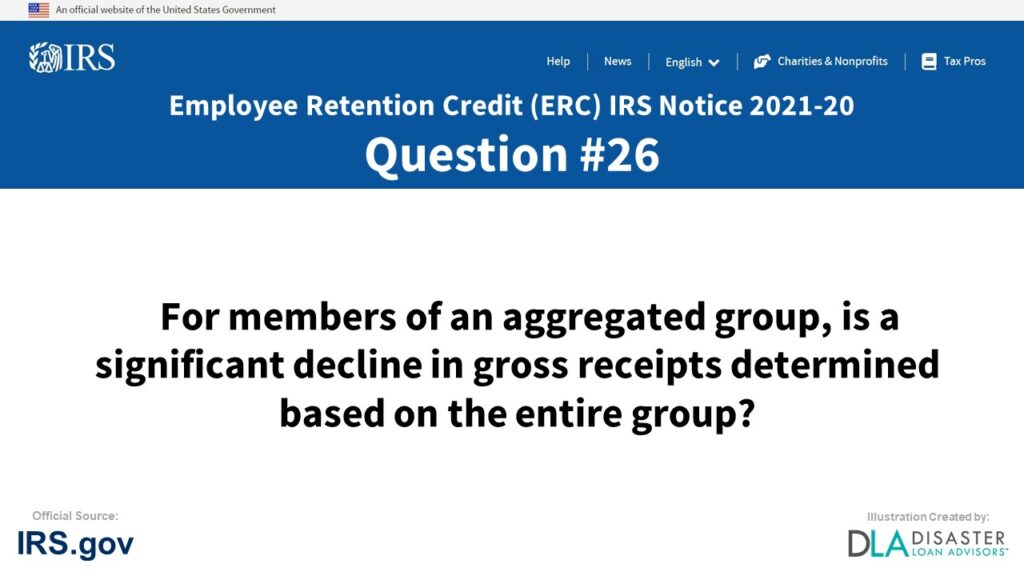
Question #26:
For members of an aggregated group, is a significant decline in gross receipts determined based on the entire group?
Found under the E. Significant Decline in Gross Receipts section of the Employee Retention Credit (ERC) IRS Notice 2021-20 with updated guidance to help business owners follow the current ERC rules.
The answer to question #26, For members of an aggregated group, is a significant decline in gross receipts determined based on the entire group?, can be found below.
ERC IRS Notice 2021-20 Question #26:
E. Significant Decline in Gross Receipts
For members of an aggregated group, is a significant decline in gross receipts determined based on the entire group?
Yes. All entities that are treated as a single employer under the aggregation rules are treated as a single employer for purposes of determining whether the employer experienced a significant decline in gross receipts. To be an eligible employer on the basis of a significant decline of gross receipts, the employer must take into account the gross receipts of all members of the aggregated group. If the aggregated group does not experience a significant decline in gross receipts, then no member of the group may claim the employee retention credit on that basis.
Example: Employer B and Employer C are members of a section 52(a) controlled group of corporations and are treated as a single employer under the aggregation rules. Because Employer B and Employer C are treated as a single employer under the aggregation rules, they must be treated as a single employer for purposes of determining whether there has been a significant decline in gross receipts. Neither Employer B nor Employer C is subject to a governmental order suspending business operations. Employer B has gross receipts of $1,000,000 in the second quarter of 2019 and $400,000 in the second quarter of 2020. Employer C has gross receipts of $1,000,000 in the second quarter of 2019 and $750,000 in the second quarter of 2020.
Although Employer B’s gross receipts in the second quarter of 2020 were 40 percent of its 2019 second quarter gross receipts, neither Employer B nor Employer C can claim the employee retention credit due to a significant decline in gross receipts. This is because Employers B and C are treated as a single employer for purposes of the employee retention credit and had combined gross receipts of $2,000,000 in the second quarter of 2019 and $1,150,000 in the second quarter of 2020. Their combined gross receipts for the second quarter of 2020 would have had to be less than $1,000,000 (50 percent of $2,000,000) for Employers B and C to have experienced a significant decline in gross receipts for the second quarter of 2020.
For more information about the Employee Retention Credit (ERC) IRS Notice 2021-20, visit the Internal Revenue Service (IRS) Department of the Treasury, official IRS.gov tax website.
Conclusion and Summary on For members of an aggregated group, is a significant decline in gross receipts determined based on the entire group? – #26 ERC IRS Notice 2021-20
The answer to Question #26: “For members of an aggregated group, is a significant decline in gross receipts determined based on the entire group?” was answered in detail above. It was found under section “E. Significant Decline in Gross Receipts” in IRS Notice 2021-20.
Leave a comment below if you have further questions on the Employee Retention Credit (ERC) or for clarifications on For members of an aggregated group, is a significant decline in gross receipts determined based on the entire group?
Employee Retention Tax Credit (ERTC): Expert Assistance to Claim Your Business ERC Credit
Up to a $26,000 ERC Refund from the IRS for Each Employee
Disaster Loan Advisors can assist your business with the complex and confusing Employee Retention Credit (ERC), Form 941-X, and the Employee Retention Tax Credit (ERTC) program.
Depending on eligibility, business owners and companies can receive up to $26,000 per employee based on the number of W2 employees you had on the payroll in 2020 and 2021.
The ERC / ERTC Tax Credit Program is a valuable IRS tax credit you can claim. This is money you have already paid to the IRS in payroll taxes for your W2 employees.
We DO NOT charge a percentage (%) of your ERC Refund like some companies are charging. Some ERC firms out there are charging upwards of 15% to 35% of your ERC refund!
Our professional ERC fee and pricing structure is very reasonable in comparison.
If you are looking for an ERC Company that believes in providing professional ERC Services and value, in exchange for a fair, reasonable, and ethical fee for the amount of work required, Disaster Loan Advisors is a good fit for you.
Schedule Your Free Employee Retention Credit Consultation to see what amount of employee retention tax credit your company qualifies for.
Cover Image Credit: Irs.gov / IRS Notice 2021-20 / Disaster Loan Advisors.
